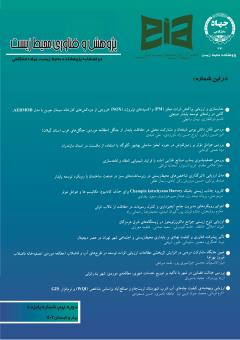اجرای رویکردهای مدیریت جامع آبخیزداری و کنترل رسوبات در حفاظت از تالاب انزلی
محورهای موضوعی : پایداری اکوسیستم ها
مکرم روانبخش سنگجویی
1
![]() ,
مائده قربان پور
2
,
مائده قربان پور
2
![]() ,
کیوان اسدی
3
,
محمدرضا رحمانی راد
4
,
کیوان اسدی
3
,
محمدرضا رحمانی راد
4
1 - گروه پژوهشی محیط زیست طبیعی، پژوهشکده محیط زیست جهاد دانشگاهی، رشت
2 - دانش آموخته دکتري علوم و مهندسی مرتع، دانشگاه علوم کشاورزي و منابع طبیعی ساري، مازندران
3 - دکتري اقلیم شناسی ، معاونت آبخیزداري اداره کل منابع طبیعی استان گیلان
4 - دانش آموخته دکتري علوم و مهندسی مرتع، دانشگاه علوم کشاورزي و منابع طبیعی ساري، مازندران
کلید واژه: آبخیزداری, تالاب انزلی, رسوبات, فرسایش ,
چکیده مقاله :
تالابها زیربنای زیستبومها و از مهمترین و در معرض خطرترین اکوسیستمهای پیچیده جهانی هستند و مجموعهای از عملکردهای بومشناختی و خدمات اکوسیستمی تأمین کننده رفاه انسانی را ارائه میکنند. تالاب انزلی، یکی از بزرگترین تالابهای ساحلی ایران به دلیل اهمیت جهانی آن از نظر تنوع زیستی شناخته شده است. امروزه، افزایش رسوبگذاری ناشی از عوامل مختلف مانند جنگلزدایی، تغییر کاربری اراضی و سدسازی رودخانهها، عمق کلی آب تالاب را کاهش داده و در نتیجه تعادل و سلامت اکولوژیکی، تنوع زیستی و پایداری آن را با چالش جدی مواجه کرده است. در این مقاله، اثرات رسوبگذاری و پیامدهای مخرب آن بر تالاب انزلی و اقدامات آبخیزداری انجام شده، بررسی شده است. نتایج این مطالعه نشان داد که حوزه آبخیز تالاب انزلی، به ویژه حوزه آبخیز فوقانی، منبع اصلی بار رسوب به تالاب است. تقریباً 80 درصد از بار کل رسوب از حوزه آبخیز بالادست میآید. چرای بیش از حد، جنگلزدایی و اقدامات محدود کنترل فرسایش از جمله دلایل اصلی فرسایش هستند. اگرچه تلاشهایی برای کنترل فرسایش خاک از طریق اجرای طرحهای مکانیکی، بیولوژیکی و بیومکانیکی در اراضی کوهستانی انجام شده است، تا بار رسوبی از حوضه فوقانی را به حداقل برسانند. اما هنوز مناطق زیادی بهدلیل کمبود بودجه، اصلاح نشدهاند. از طرف دیگر، این طرحها با چالش عدم مشارکت همه جانبه ذینفعان و مشارکت جامعه در فرآیندهای برنامهریزی و اجرا مواجه هستند. اجرای رویکردهای جامع آبخیزداری که همکاری بین ذینفعان را تقویت میکند و عوامل اقتصادی-اجتماعی را مورد توجه قرار میدهد، نه تنها از این اکوسیستم حیاتی محافظت میکند، بلکه توسعه پایدار و بهبود کیفیت زندگی جوامعی را که به منابع آن وابسته هستند، ارتقا میدهد.
Wetlands are the foundation of ecosystems and are among the most important and endangered complex ecosystems globally, providing a range of ecological functions and ecosystem services that support human well-being. Anzali wetland, as one of the largest coastal wetlands in Iran, is known for its global importance in terms of biodiversity. Today, the increase in sedimentation caused by various factors such as deforestation, land use change and river damming has reduced the overall water depth of the wetland, and as a result, its ecological balance and health, biodiversity and sustainability have faced a serious challenge. In this article, the effects of sedimentation and its destructive consequences on the Anzali wetland and the taken watershed management measures have been investigated. This article examines the effects of sedimentation and its destructive consequences on Anzali Wetland, as well as the watershed management measures taken. The results of this study indicate that the watershed of Anzali wetland, particularly the upper watershed, is the main source of sediment load to the wetland. Approximately 80% of the total sediment load comes from the upstream watershed. Overgrazing, deforestation, and limited erosion control measures are among the primary causes of erosion. Overgrazing, deforestation and erosion are the main causes of erosion. Although some efforts have been made to control soil erosion by implementing mechanical, biological, and biomechanical plans in mountainous areas to minimize sediment load from the upper basin, many regions remain not modified due to budget constraints. On the other hand, these plans are facing the challenge of a lack of comprehensive stakeholder participation and community involvement in planning and implementation processes. Implementing comprehensive watershed management approaches that strengthen stakeholder collaboration and consider socio-economic factors not only protects this vital ecosystem but also promotes sustainable development and improves the quality of life for communities that depend on its resources.
